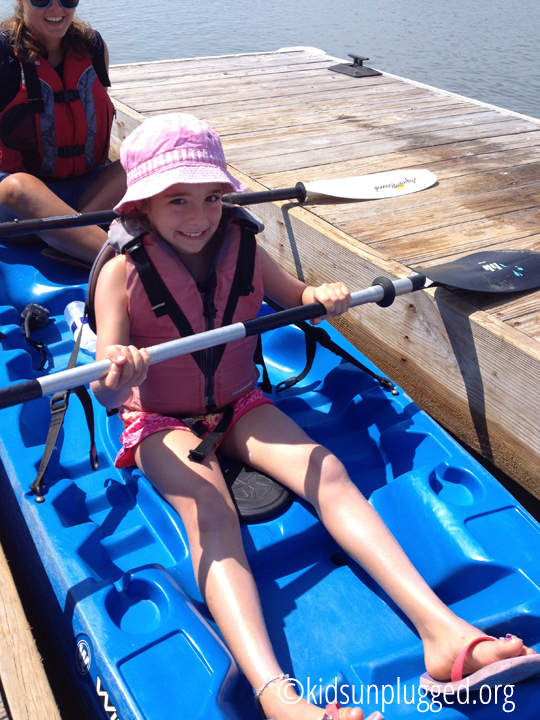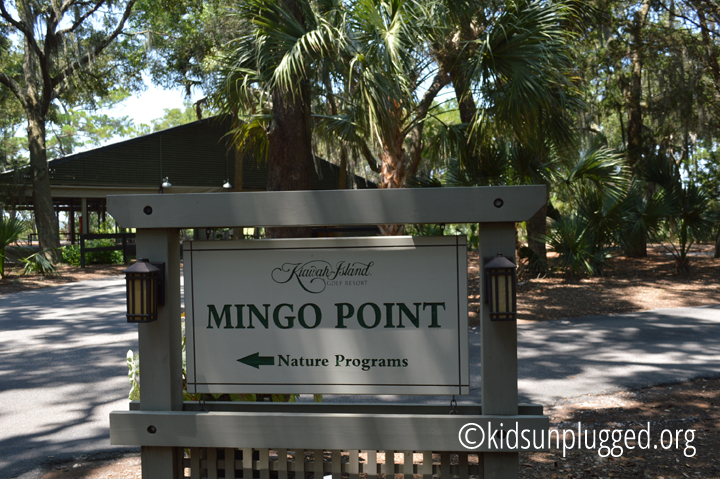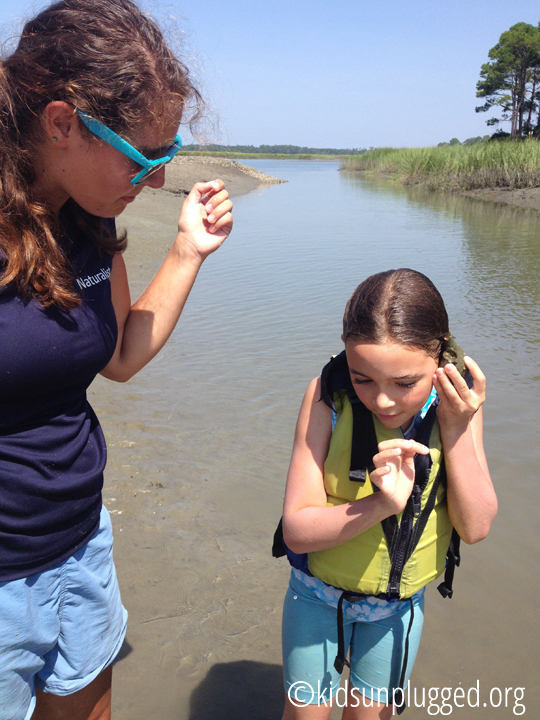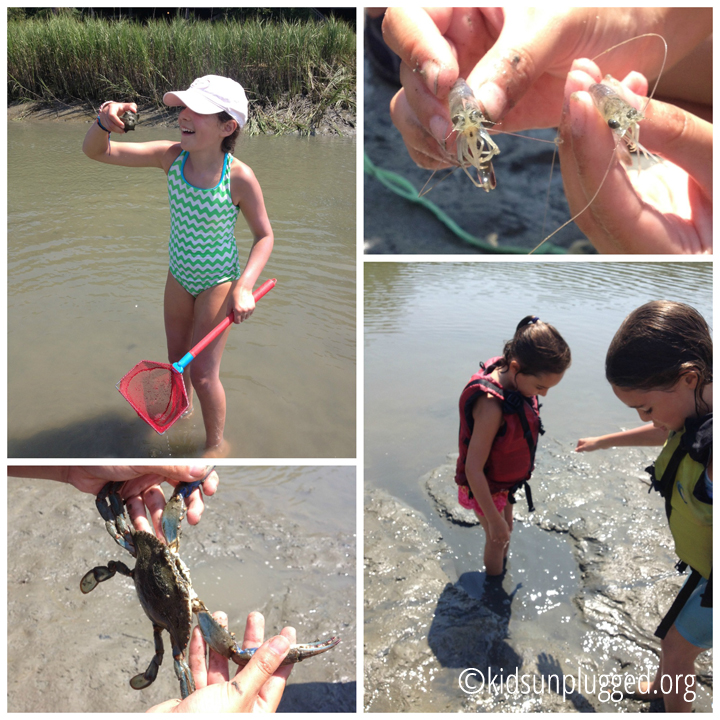
“Look! I’m stuck! I need to be rescued!” called my 8-year old daughter from where she was standing in a nearby tide pool. With a net in her hand and a grin on her face, she tried to pull her feet free from where they’d been sucked into the glue-like mud that lived below the surface. She was very pleased with herself.
It was August and we were taking a road trip to Florida to visit my maternal grandmother, who refused to fly north any longer. I convinced my dad to come along for the ride and began searching for an unplugged destination to visit along the way. Through a fellow travel writer I found Kiawah Island, South Carolina and after a bit of research decided it was the ideal place to feature.
Kiawah is a luxurious golf resort first, yet has an extensive, on-site nature program and I was eager to try some of the unique outdoor activities designed especially for families. The one that seemed especially intriguing was the Pluff Mud Paddle and I signed us up to participate during our visit.
 Despite my girls’ incessant questions about what the excursion involved, I wasn’t sure what to tell them to expect. I shared that it was a beginner-level paddle to a nearby salt marsh where, at low tide, there would be lots of squishy mud and plenty of ocean critters to discover. It was the squishy mud factor upon which they fixated. “How much mud is there?” “Will it really suck us in?” “Is it going to stink like low tide?” “I don’t think I want to get all covered with mud.” I didn’t have the answers and I think each of us thought we’d all wind up waist deep in a swamp when the time came.
Despite my girls’ incessant questions about what the excursion involved, I wasn’t sure what to tell them to expect. I shared that it was a beginner-level paddle to a nearby salt marsh where, at low tide, there would be lots of squishy mud and plenty of ocean critters to discover. It was the squishy mud factor upon which they fixated. “How much mud is there?” “Will it really suck us in?” “Is it going to stink like low tide?” “I don’t think I want to get all covered with mud.” I didn’t have the answers and I think each of us thought we’d all wind up waist deep in a swamp when the time came.
During dinner on our first evening on Kiawah, two of the girls and I went to find a map of the island at the front desk in order to get the lay of the land before setting off for the next days adventures. Katherine, who was manning the desk that evening, was very enthusiastic when she heard we would be paddling out to explore the pluff mud. She grew up playing in that mud, she told us, and she knew that we were going to love it. The girls hit her with their list of questions and this is what we learned:
- There is usually a lot of mud
- Yes, it can suck you in, but you can usually get unstuck by yourself
- Yes, the mud is pretty stinky, it’s smell is famous in the South Carolina Lowcountry
- You can probably avoid getting completely covered in mud, but why would you want to?
I’m not sure whether or not this information gave them a clearer idea of what this paddling tour was going to entail, but I finally told them that they’d just have to wait until tomorrow and see for themselves.
Exploring Kiawah’s Watery World
All of the water activities and excursions offered through the Kiawah Island Nature Program begin at Mingo Point on the island’s west end including kayaking tours and rentals, stand-up paddle boarding, fishing excursions, dolphin watching trips.
 We arrived a few minutes late for our eleven o’clock paddle and were greeted by Ally and Will, the naturalists who would be guiding that morning’s pluff mud tour. Ally gave us a brief lesson in navigation, fitted us with life jackets and handed us our paddles before leading the way to the dock. Sunscreen applied, we organized ourselves into pairs for the 2-man sit upon kayaks. I teamed up with my middle daughter while the 12-year old joined my dad. Small, as we affectionately call her, hopped aboard with Ally and we paddled out to join the others.
We arrived a few minutes late for our eleven o’clock paddle and were greeted by Ally and Will, the naturalists who would be guiding that morning’s pluff mud tour. Ally gave us a brief lesson in navigation, fitted us with life jackets and handed us our paddles before leading the way to the dock. Sunscreen applied, we organized ourselves into pairs for the 2-man sit upon kayaks. I teamed up with my middle daughter while the 12-year old joined my dad. Small, as we affectionately call her, hopped aboard with Ally and we paddled out to join the others.
What is Pluff Mud?
Ally and Will lead us down a tidal trail of the Kiawah River considered a non-riverine tidal estuary. The brackish saltmarshes of the South Carolina Lowcountry are home to abundant flora and fauna and pluff mud is a product of the plants and animals that die in the marsh, sink into the mud and decompose. That decomposition creates a nutrient-rich, relatively stinky mud that has a tendency to trap you up to your knees with a powerful, vacuum-like tenacity. Local folks will say that it is the suction-y sound the mud makes when you finally free your trapped appendages that gave it its name. Pluff mud is ideal for kids to splooge and squish and the aquatic creatures who make the marsh their home are visible everywhere.
Saltmarsh Exploration
 We paddled for about 15-20 minutes, steering clear of the razor-sharp oysters whose beds dotted the shore, to an area of the marsh where there was a wide, flat sandbar with several tide pools. Ally grabbed a seining net from her kayak and Will offered handheld nets to the kids for critter catching. They asked us to be sure to return any animals we found to their underwater homes after examining them and showed us a good spot to swim. It was a steamy 93-degrees already and the bath-like water, while fun to swim in, was not exactly refreshing.
We paddled for about 15-20 minutes, steering clear of the razor-sharp oysters whose beds dotted the shore, to an area of the marsh where there was a wide, flat sandbar with several tide pools. Ally grabbed a seining net from her kayak and Will offered handheld nets to the kids for critter catching. They asked us to be sure to return any animals we found to their underwater homes after examining them and showed us a good spot to swim. It was a steamy 93-degrees already and the bath-like water, while fun to swim in, was not exactly refreshing.
Ally and Will were enthusiastic and knowledgeable and engaged both the kids and adults alike the entire time. They searched for critters themselves and shared plenty of information about the creatures they pulled from the water.
The next hour was spent exploring the marsh. Our ears filled with the squeals and shouts of the kids as they discovered yet another interesting organism or were vacuumed ankle-deep into the mud. We caught large, jumpy shrimp and pinch-y blue crabs in our nets, watched as colonies of fiddler crabs scurried two and fro among the marsh grasses and saw a pair of dolphins gliding past in the creek.

I waded into the soft, squishy tide pool toward my daughter as the water sparkled around us and small mullet leapt from the creek. She reached out to me and I grabbed her firmly under her armpits and pulled upward. Her feet slowly popped out of the mud—PLLUUUFF!
 The Kiawah Island Nature Program offers several different paddling tours daily and I’m sure each one of them is equally wonderful. The surrounding natural beauty of the island is a joy to explore and time spent kayaking on Kiawah’s tidal trails is a fabulous way to do it.
The Kiawah Island Nature Program offers several different paddling tours daily and I’m sure each one of them is equally wonderful. The surrounding natural beauty of the island is a joy to explore and time spent kayaking on Kiawah’s tidal trails is a fabulous way to do it.
Disclosure: We were hosted by the Kiawah Resort and our accommodations, dinners and activities were complimentary. As always, all of the opinions in this post are my own.

Speak Your Mind